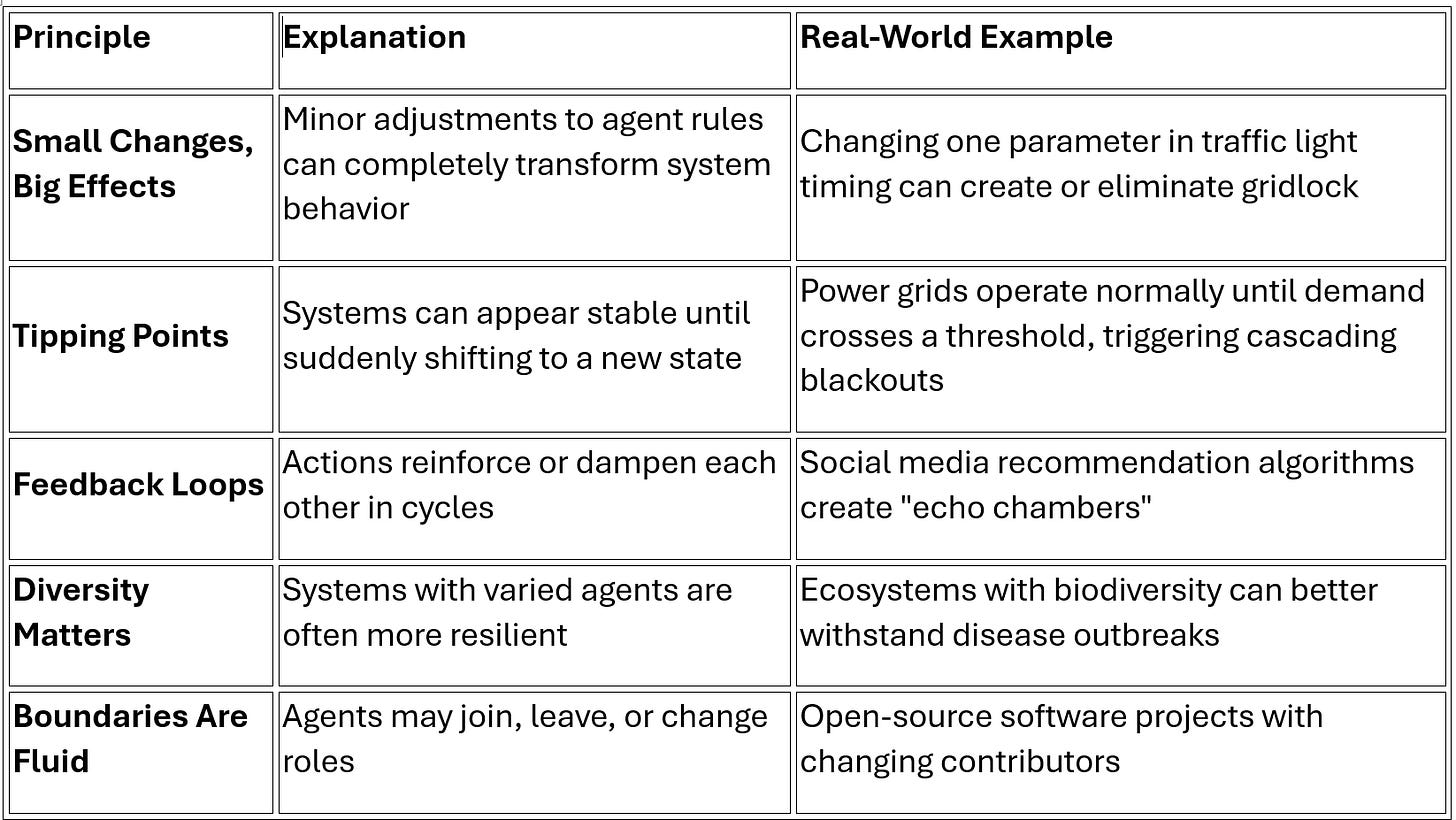Emergent Behavior in Multi-Agent Systems
The Future is Emerging
Complex systems are beginning to act and adapt in ways no single operator directs. A Ukrainian drone swarm suddenly changes formation to exploit a gap in Russian air defences—without explicit commands from any operator. Networked missile defence systems prioritize threats and coordinate countermeasures faster than any human commander could direct. These capabilities share a powerful characteristic: they emerge naturally from the interactions of autonomous systems following simple programming rules, not from centralized command structures.
This phenomenon—called emergent behavior—will rapidly transforming modern defence systems. As military operations increasingly depend on autonomous and semi-autonomous systems, understanding emergence isn't just an academic exercise—it represents a fundamental shift in how we think about command and control, operational planning, and strategic advantage.
For defence professionals, emergence presents both unprecedented opportunity and profound risk. Those who master the principles of emergent systems gain asymmetric advantages in speed, adaptability, and resilience. Those who fail to understand emergence risk mission failure when autonomous systems behave in ways no planner anticipated.
1. What Is Emergent Behavior? A Simple Explanation
Emergent behavior occurs when many independent agents (whether people, AI systems, or robots) follow rules that, when combined, create complex system-wide patterns that no one directly programmed or commanded.
Think of it like this: an ant colony builds sophisticated structures without any single ant understanding the overall design. Each ant follows basic rules, but collectively they create something far more complex than any individual could conceive.
In technical terms, a Multi-Agent System (MAS) is any collection of semi-independent actors that interact with each other and their environment. These could be:
Autonomous drones in military operations
AI traffic management systems in cities
Smart devices in an electrical grid
Trading algorithms in financial markets
Key characteristics that make emergent behavior important:
Bottom-up, not top-down: Complex behaviors arise from simple rules, not central control
Unexpected outcomes: Results often surprise even the designers of the system
Self-organizing: Patterns form and maintain themselves without external direction
Difficult to reverse: Once established, emergent patterns can be hard to change
2. Why Emergent Behavior Matters Now
Emergent behavior is actively shaping real-world systems faster than our traditional management approaches can handle.
Real-world relevance: These systems are already making decisions that affect your life—from how power is distributed during peak usage to how emergency services respond during crises.
3. Emergent Behavior in Action: Current Examples
Military Drone Swarms
Military forces are developing drone swarms where dozens or hundreds of small, relatively simple drones work together without centralized control. If several drones are destroyed, the remaining ones automatically reorganize to complete the mission. This adaptive behavior emerges from basic programmed rules rather than specific commands.
Fiber-Optic Drone Swarms (Ukraine Conflict, 2024–2025)
Ukrainian forces deploy tethered kamikaze drones using fiber-optic links to evade RF jamming. Drones adaptively exploit openings in enemy defences without top-down coordination, forming new pathways for follow-on attacks.
Smart Traffic Management
Cities like Seoul are testing AI traffic systems that adjust signal timing based on real-time conditions. An interesting emergent pattern has appeared: while main roads see improved flow, side streets sometimes experience unexpected congestion patterns that weren't programmed intentionally but emerged from the system's optimization rules.
Power Grid Management
As millions of homes install smart thermostats and solar batteries, energy companies have observed unexpected patterns in power consumption. When many devices independently respond to price signals, they can accidentally synchronize, creating demand spikes that strain the grid—behavior no single device owner or programmer intended.
Financial Markets
High-frequency trading algorithms interact in milliseconds, creating market patterns that no human trader could generate or predict. "Flash crashes," where markets plunge in minutes before recovering, are emergent behaviors from algorithm interactions.
4. How Emergence Works
The Emergence Process:
Local Interactions: Individual agents follow simple rules based only on their local environment
Feedback Loops: Agents respond to the actions of nearby agents, creating chain reactions
Threshold Effects: When enough agents behave similarly, the system reaches a tipping point
Global Patterns: Complex, system-wide behaviors appear that no individual agent "understands"
Consider a traffic jam:
Each driver follows simple rules (maintain safe distance, brake when the car ahead brakes)
One driver slows slightly, causing the next to brake slightly harder
This amplifies backward through the line of cars (feedback loop)
Eventually, cars far back are stopping completely
Result: A traffic jam emerges, even though no single driver caused it
5. Key Principles for Understanding Emergent Systems
6. Steering Rather Than Controlling: A New Approach
Traditional management focuses on top-down control. With emergent systems, this approach often fails. Instead, let’s consider:
7. Implications for Our Future
As multi-agent systems become more common, we need to rethink how we design, manage, and govern our world:
For Policymakers: Traditional regulations that assume central control may be ineffective. New approaches may be needed that shape the "rules of the game" agents follow.
For Businesses: Competitive advantage may come from understanding and harnessing emergence rather than trying to control every process.
For Citizens: Digital literacy should include understanding how interacting systems shape our environment in unexpected ways.
For Military and Security: Future conflicts may be characterized by emergent behaviors across human and autonomous systems that no strategist explicitly planned.
Learning to Dance with Complexity
Emergent behavior isn't going away—it's becoming more prevalent as our world grows more connected and autonomous. Rather than fighting this complexity or pretending we can control it completely, success will come from learning to sense, understand, and gently guide these systems.
Emergence is inevitable. Unguided emergence is optional.





